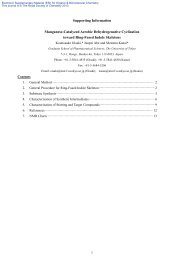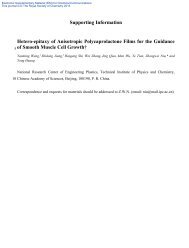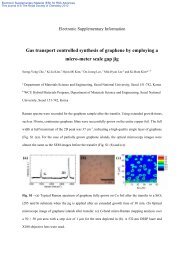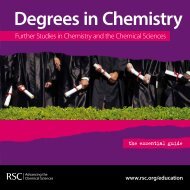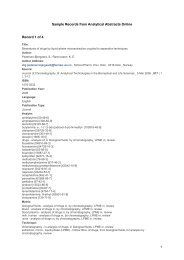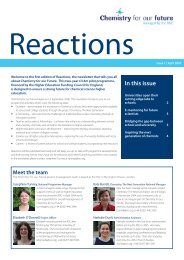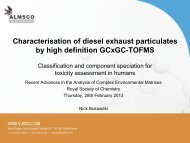Atom and molecule: upper secondary school French students ...
Atom and molecule: upper secondary school French students ...
Atom and molecule: upper secondary school French students ...
Create successful ePaper yourself
Turn your PDF publications into a flip-book with our unique Google optimized e-Paper software.
A. Cokelez <strong>and</strong> A. Dumon 126<br />
of four electron pairs around the symbol of the element (<strong>and</strong> this accounts for 13% <strong>and</strong> 10%),<br />
followed by the showing of the six outside electrons (10% <strong>and</strong> 7%).<br />
The use of the atomic composition model, <strong>and</strong> more particularly that of ‘neutral atom’,<br />
reaches a maximum when <strong>students</strong> enter grade 11, whereas it accounts for a majority of<br />
representations in the textbooks of grade 9. It seems therefore, that its adoption, however low,<br />
is favoured in the teaching of the electronic structure <strong>and</strong> nucleus composition. A low<br />
percentage in the choice of electron cloud model can be seen among different grades,<br />
although it is the description that textbooks authors as well as curricula developers favour.<br />
Thus, as Harrison <strong>and</strong> Treagust (1996, 2000) showed in their work, such a model is not easily<br />
grasped by <strong>students</strong>.<br />
Another interesting observation is that the use of the solar system model of atom<br />
increases from grade 10 to grade 12. Yet this model is not often used in textbooks, as it<br />
appears only in documents with historical contents. Moreover, although Official Instructions<br />
forbid the representation of the solar system model in shells in 2D, some <strong>students</strong> (8% in<br />
grade 10, 10% in grade 11 <strong>and</strong> 11% in grade 12) choose this diagram. Is that a consequence<br />
of <strong>school</strong> knowledge or is it the <strong>students</strong>' own conception to represent electronic shells?<br />
Finally, as far as other representations are concerned, they can mainly be explained by<br />
the confusion between atom <strong>and</strong> <strong>molecule</strong>. One can regret that 5% of grade 12 <strong>students</strong> still<br />
remain at this level!<br />
Description of the atom<br />
A vast majority of <strong>students</strong> cannot produce a minimum level of description of the concept<br />
of atom required at the end of each grade. The differences observed between the three grades<br />
prove that if the teaching in grade 10 brings along a clearly positive evolution, the concept is<br />
not well absorbed. Indeed, whenever it is not the subject of teaching (i.e. in grade 11), its<br />
minimum characteristics appear to have been forgotten by the following year.<br />
The minimum level judged acceptable at the end of grade 9, (L1) is only reached by 21%<br />
of grade 10 <strong>students</strong>, 47% of grade 11 <strong>students</strong> <strong>and</strong> down to 25% of <strong>students</strong> at the beginning<br />
of grade 12. As far as the minimal level acceptable at grade10 is concerned (L3), only 35% of<br />
grade 11 <strong>students</strong> <strong>and</strong> 15% of grade 12 <strong>students</strong> reach it. (The levels of description are<br />
described on p. 124.)<br />
Figure 4: Comparison of the levels of description of the atom at different<br />
grades<br />
Answers<br />
(%/R)<br />
80<br />
70<br />
60<br />
50<br />
40<br />
30<br />
20<br />
10<br />
0<br />
L.0 L.1 L.2 L.3 L.4 L.5 L.6<br />
Grade 10 79 12 4 2 3 0 0<br />
Grade 11 53 11 1 7 13 9 6<br />
Grade 12 75 9 1 3 6 3 3<br />
From the diagrams <strong>and</strong> keywords, we have tried to discover what competences expected<br />
at the end of grade 10 appear in the <strong>students</strong>’ answers at grades 11 <strong>and</strong> 12:<br />
Chemistry Education Research <strong>and</strong> Practice, 2005, 6 (3), 119-135<br />
This journal is © The Royal Society of Chemistry




